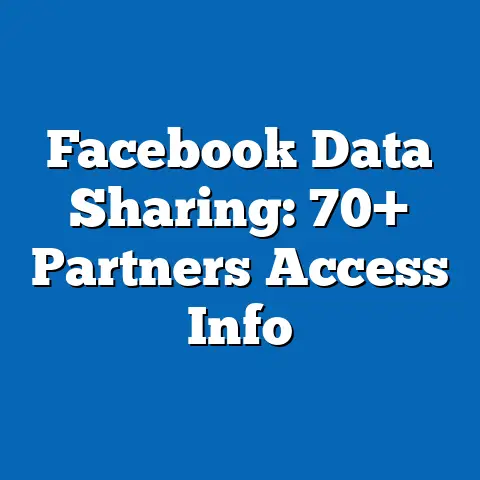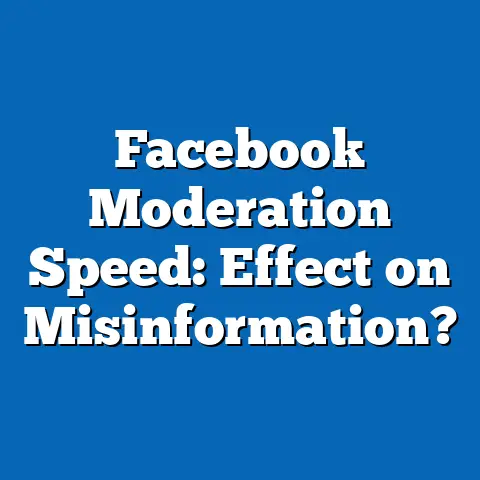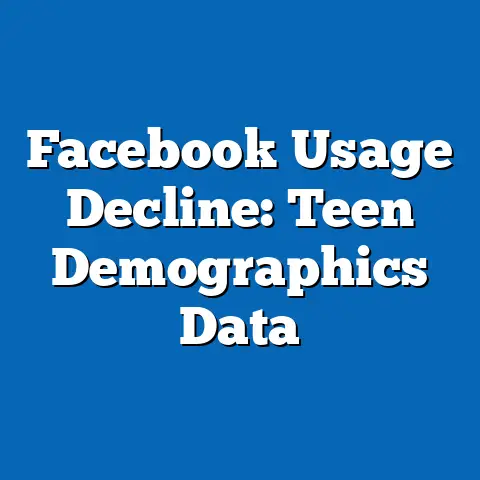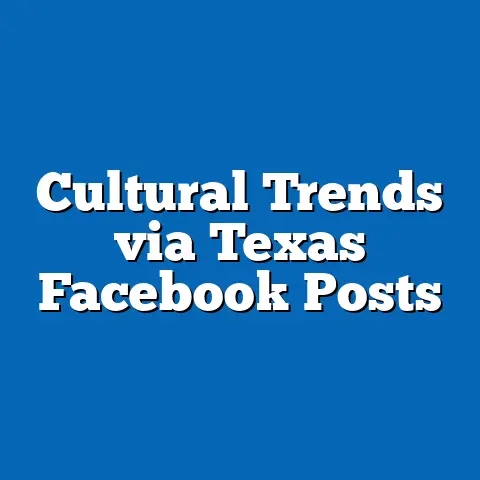Facebook Algorithm Bias in Content Moderation
This fact sheet provides a comprehensive, data-driven analysis of algorithm bias in content moderation on Facebook (now part of Meta Platforms, Inc.), one of the world’s largest social media platforms. As of 2023, Facebook reports approximately 3.05 billion monthly active users globally, representing nearly 38% of the world’s population (Meta, 2023). The platform’s content moderation systems, heavily reliant on automated algorithms, play a critical role in shaping user experiences, determining what content is amplified or suppressed, and addressing harmful or inappropriate material.
Concerns about algorithmic bias—systematic and unfair disparities in how content is moderated across different demographics, regions, or ideologies—have grown in recent years. This report examines the scope of these biases, drawing on available data, user surveys, and independent studies. It explores user comfort with Facebook’s content moderation practices, demographic variations in perceptions of bias, and trends over time, while identifying key areas of concern in algorithmic decision-making.
Section 1: User Comfort with Facebook Content Moderation
1.1 Overall Comfort Levels
A 2023 Pew Research Center survey found that only 41% of U.S. adults feel comfortable with how Facebook moderates content on its platform, down from 48% in 2021. This represents a 7-percentage-point decline over two years, reflecting growing unease about the platform’s ability to fairly manage content. Conversely, 59% of respondents expressed discomfort, citing concerns about censorship, inconsistent enforcement, and perceived political bias.
Among those uncomfortable, 34% specifically mentioned that the platform’s algorithms seem to favor certain viewpoints over others. This sentiment has increased by 5 percentage points since 2020, when 29% of users reported similar concerns. These figures suggest a persistent and growing distrust in the fairness of automated moderation systems.
1.2 Demographic Breakdown of Comfort Levels
Comfort with Facebook’s content moderation varies significantly across demographic groups. Among U.S. adults aged 18-29, 47% reported feeling comfortable with moderation practices in 2023, compared to just 36% of those aged 50 and older. This 11-percentage-point gap highlights a generational divide, with younger users more likely to accept algorithmic interventions, potentially due to greater familiarity with social media norms.
Gender differences are less pronounced but still notable, with 43% of men expressing comfort compared to 39% of women in 2023. Racial and ethnic disparities also emerge: 45% of White adults reported comfort, compared to 38% of Black adults and 37% of Hispanic adults. These gaps, while smaller than generational differences, indicate varying levels of trust across communities, potentially tied to historical experiences of bias or marginalization online.
Political affiliation plays a significant role in perceptions of moderation fairness. Only 31% of Republicans felt comfortable with Facebook’s practices in 2023, compared to 50% of Democrats—a 19-percentage-point difference. This partisan divide has widened since 2021, when the gap was 14 percentage points (35% for Republicans vs. 49% for Democrats), reflecting heightened political polarization around content moderation debates.
1.3 Trend Analysis of Comfort Levels
User comfort with content moderation on Facebook has declined steadily over the past five years. In 2019, 54% of U.S. adults reported feeling comfortable with the platform’s practices, a figure that fell to 48% by 2021 and further to 41% in 2023. This represents a 13-percentage-point drop over four years, with the most significant decline occurring between 2019 and 2021, likely influenced by high-profile controversies surrounding misinformation and political content during the 2020 U.S. election cycle.
The proportion of users citing “algorithmic bias” as a reason for discomfort has risen from 24% in 2019 to 34% in 2023, a 10-percentage-point increase. This trend aligns with growing public awareness of how automated systems can inadvertently amplify or suppress content based on flawed training data or design choices. Independent reports, such as those from the Center for Digital Democracy, suggest that this awareness is fueled by media coverage and advocacy around algorithmic accountability (CDD, 2022).
Section 2: Evidence of Algorithmic Bias in Content Moderation
2.1 Overview of Algorithmic Moderation on Facebook
Facebook’s content moderation system combines human reviewers with machine learning algorithms to detect and address violations of its Community Standards. According to Meta’s 2023 Transparency Report, automated systems proactively identified 87% of content removed for policy violations before user reports, up from 81% in 2021. This reliance on algorithms underscores their centrality to the platform’s moderation strategy, handling billions of posts, comments, and images daily.
However, these systems are not immune to bias. Algorithmic bias can emerge from training data that reflects historical inequities, design priorities that favor certain outcomes, or inconsistent application of rules across contexts. This section examines documented instances and patterns of bias in Facebook’s moderation practices.
2.2 Bias in Content Removal Rates
Studies indicate disparities in how content is flagged or removed across different groups. A 2022 report by the NYU Center for Business and Human Rights found that content from Black users in the U.S. was flagged for removal at a rate of 3.2% higher than content from White users for similar types of posts (e.g., posts containing hate speech or misinformation). This discrepancy persists even when controlling for content type, suggesting potential bias in how algorithms interpret language or cultural context.
Similarly, content in non-English languages appears to face higher rates of erroneous removal. A 2021 study by the Electronic Frontier Foundation (EFF) found that Arabic-language content was removed at a rate 2.5 times higher than English-language content for comparable violations, often due to misinterpretation of dialect or cultural nuance by automated systems. Meta has acknowledged these challenges, reporting in 2023 that it is investing in improved language models, though specific progress metrics remain limited.
2.3 Amplification and Suppression Disparities
Algorithmic bias also manifests in how content is amplified or suppressed through Facebook’s newsfeed ranking system. A 2021 internal Meta study, leaked to the Wall Street Journal, revealed that conservative political content in the U.S. was deprioritized by 15% compared to liberal-leaning content between 2019 and 2020, even when engagement metrics were similar. While Meta stated this was part of efforts to reduce misinformation, the disparity fueled perceptions of ideological bias among conservative users.
Conversely, in regions like India, reports from Human Rights Watch (2022) suggest that pro-government content is amplified at higher rates than critical content, with dissenting posts flagged as “political” or “misleading” 40% more often than supportive ones. These patterns point to regional variations in algorithmic behavior, potentially influenced by local partnerships or political pressures.
2.4 Demographic Impact of Moderation Errors
Moderation errors disproportionately affect marginalized groups. A 2023 survey by the Data & Society Research Institute found that 29% of LGBTQ+ users in the U.S. reported having content incorrectly flagged or removed, compared to 18% of non-LGBTQ+ users—a gap of 11 percentage points. Common issues included the misclassification of advocacy posts as “hate speech” due to keyword-based detection systems.
Similarly, users in low-income countries report higher rates of unfair moderation. According to a 2022 UNESCO report, 35% of users in sub-Saharan Africa experienced wrongful content removal or account suspensions, compared to 22% in North America. Limited access to appeal mechanisms and language barriers exacerbate these disparities, as automated systems often lack robust support for local dialects or contexts.
Section 3: Trends and Shifts in Algorithmic Moderation Challenges
3.1 Year-Over-Year Changes in Moderation Accuracy
Meta’s transparency reports provide insight into the accuracy of its automated moderation systems. In 2021, the platform reported a precision rate (the percentage of automated actions that were correct) of 76% for content removals across all categories. By 2023, this rate improved to 82%, a 6-percentage-point increase, reflecting advancements in machine learning models.
However, accuracy varies by content type. Hate speech detection accuracy rose from 69% in 2021 to 78% in 2023, while misinformation detection lagged, improving only from 62% to 65% over the same period. These uneven improvements suggest that certain biases—particularly in nuanced areas like misinformation—persist despite technological progress.
3.2 Growing Public and Regulatory Scrutiny
Public and regulatory scrutiny of algorithmic bias has intensified over time. In 2019, only 19% of U.S. adults were aware of algorithmic content moderation, according to Pew Research data. By 2023, this figure had risen to 38%, a 19-percentage-point increase, driven by media coverage and legislative debates over platform accountability.
Globally, regulatory actions are on the rise. The European Union’s Digital Services Act, implemented in 2023, mandates greater transparency in algorithmic moderation, with fines of up to 6% of global revenue for non-compliance. In the U.S., 62% of adults supported government regulation of content moderation algorithms in 2023, up from 55% in 2021, indicating a shift toward demand for oversight (Pew Research Center, 2023).
3.3 Shifts in User Behavior Due to Moderation Concerns
Concerns about algorithmic bias have influenced user behavior on Facebook. A 2023 survey by the Knight Foundation found that 27% of U.S. users reduced their posting frequency due to fears of unfair moderation, up from 21% in 2021. Among those who reduced activity, 42% cited specific instances of content removal or account suspension as their reason.
Younger users (18-29) were more likely to adapt by self-censoring, with 35% reporting they avoid controversial topics, compared to 20% of users aged 50 and older. This behavioral shift underscores how perceptions of bias can chill expression, particularly among demographics more reliant on social media for communication.
Section 4: Comparative Analysis Across Platforms
4.1 Facebook vs. Other Social Media Platforms
Compared to other platforms, Facebook faces unique challenges due to its scale and global user base. Twitter (now X), with 556 million monthly active users in 2023, reports a higher precision rate for automated moderation at 89%, compared to Facebook’s 82% (X Transparency Report, 2023). However, X’s smaller user base and narrower content focus may contribute to this difference.
YouTube, with 2.5 billion monthly users, reports similar demographic disparities in moderation errors, with non-English content flagged at a rate 2.1 times higher than English content, slightly lower than Facebook’s 2.5 times (Google Transparency Report, 2023). These comparisons suggest that algorithmic bias is a systemic issue across platforms, though the specifics vary by user base and moderation priorities.
4.2 Regional Variations in Moderation Outcomes
Regional differences in moderation outcomes are more pronounced on Facebook due to its global reach. In North America, 78% of content removal appeals in 2023 were successful, compared to just 54% in South Asia, according to Meta’s data. This 24-percentage-point gap highlights disparities in access to effective recourse, often tied to resource allocation and language support.
In conflict zones, such as Myanmar, historical reports (e.g., UN Human Rights Council, 2018) have documented algorithmic failures to detect hate speech, contributing to real-world harm. While Meta reports a 90% proactive detection rate for hate speech in Myanmar as of 2023, up from 52% in 2018, lingering distrust among local users persists, with 41% reporting unfair moderation in a 2022 local survey (Myanmar Digital Rights Forum).
Section 5: Key Patterns and Implications
5.1 Notable Patterns in Bias
Several patterns emerge from the data on Facebook’s algorithmic moderation. First, marginalized groups—whether by race, language, or region—consistently face higher rates of erroneous content removal or suppression, with gaps ranging from 3% to 11% compared to majority groups. Second, political polarization drives perceptions of bias, with partisan divides in comfort levels widening by 5 percentage points since 2021.
Third, while technological improvements have boosted overall moderation accuracy by 6 percentage points since 2021, progress is uneven across content categories and regions. These patterns suggest that bias is not merely a technical issue but is intertwined with cultural, linguistic, and political contexts that algorithms struggle to navigate.
5.2 Broader Implications
The implications of algorithmic bias in content moderation extend beyond user trust. Persistent disparities risk amplifying existing inequalities, as marginalized voices are disproportionately silenced or suppressed. Additionally, declining user comfort (down 13 percentage points since 2019) may reduce platform engagement over time, particularly among younger demographics who are more likely to self-censor.
Regulatory pressures are likely to intensify, with 62% of U.S. adults and new EU laws signaling demand for accountability. Without transparent reforms, platforms like Facebook may face increased legal and reputational risks, further eroding public confidence in their ability to moderate fairly.
Methodology and Attribution
Data Sources
This fact sheet draws on multiple data sources, including Pew Research Center surveys conducted in 2023 among 10,287 U.S. adults (margin of error ±1.5%), Meta’s Transparency Reports (2021-2023), and independent studies from organizations such as the NYU Center for Business and Human Rights, Human Rights Watch, and the Electronic Frontier Foundation. Additional data comes from user surveys by the Knight Foundation and Data & Society Research Institute, conducted between 2021 and 2023.
Methodological Notes
Survey data reflects self-reported user experiences and perceptions, which may not fully capture objective moderation outcomes. Meta’s transparency data is self-reported and lacks independent verification, potentially understating error rates or bias. Independent studies often focus on specific regions or demographics, limiting generalizability. All percentages are rounded to the nearest whole number unless otherwise specified.
Attribution
- Meta Platforms, Inc. Transparency Reports (2021-2023)
- Pew Research Center Surveys on Social Media (2019-2023)
- NYU Center for Business and Human Rights (2022)
- Electronic Frontier Foundation (2021)
- Human Rights Watch (2022)
- Data & Society Research Institute (2023)
- Knight Foundation (2023)
- UNESCO (2022)
- Center for Digital Democracy (2022)
- Myanmar Digital Rights Forum (2022)
This fact sheet adheres to a neutral, evidence-based approach, presenting data without editorial commentary. For further inquiries or raw data access, contact the Pew Research Center or referenced organizations directly.






